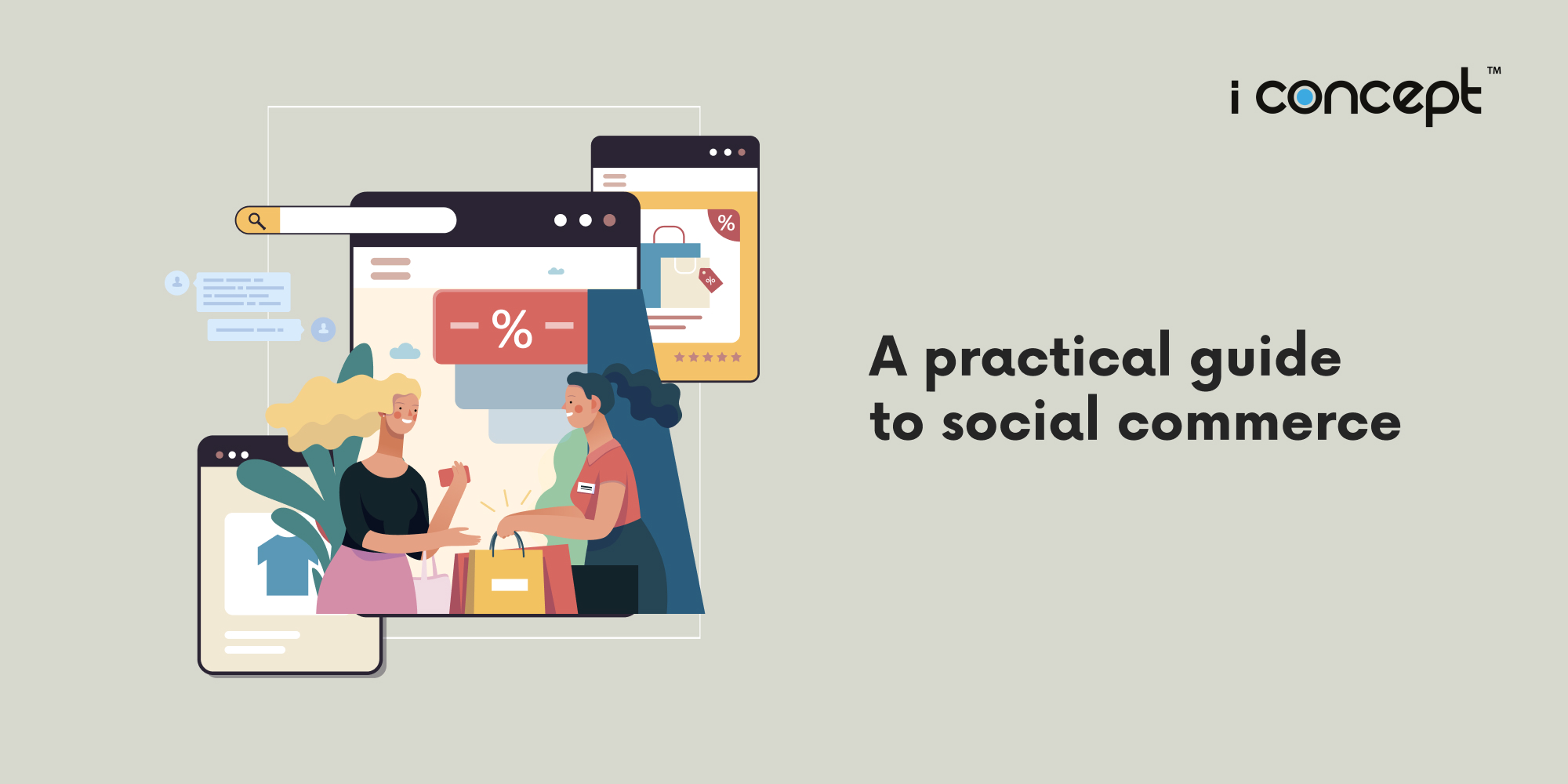In recent years, social media sites have made the likes of shoppable posts, storefronts and in-app purchases available on their platforms.
While new developments are coming on stream all the time, social commerce is already proving very lucrative for brands. In fact, it generated US$724 billion of sales in 2022. And this figure is expected to grow by almost a third annually through to 2030.
That’s why e-commerce brands need to take advantage of social commerce now. So let I Concept Singapore, your trusted creative agency, walk you through everything you need to know about social commerce.
What is social commerce?
Beyond just social media management, social commerce integrates e-commerce development into social media, allowing the sales of products directly through the platforms. This allows potential customers to engage with brands, browse products and convert – without ever leaving social media.
Unlike social media marketing, the social commerce definition usually means that customers check out directly on social media, rather than heading to a brand’s webstore.
The benefits of social commerce
Here are just a few of the key advantages that social commerce offers.
- A convenient path to purchase
Rather than redirecting consumers to a third-party site, social commerce allows them to check out wherever they are. This removes unnecessary steps and streamlines the path to purchase. Many shoppers even have their payment and shipping details saved on the platforms.
This creates a frictionless consumer journey, which is likely to generate more conversions.
- Mobile-friendly platforms
The use of mobile devices has shot up, yet a lot of e-commerce sites still aren’t optimised for the various devices out there. That’s why cart abandonment among mobile users stands at around 86% – significantly higher than for desktop users.
However, social sites can easily handle the growing volume of mobile shoppers.
- A huge market
There are some five billion social media users worldwide and many of them use these sites to conduct product research.
This means brands can reach a huge number of ready-to-buy consumers across all regions and demographics.
- You can precisely target personas
As well as providing a huge audience, social media platforms also have a massive amount of user data and offer unrivalled product ad targeting. This allows brands to create personalised customer experiences and win more sales.
- Grow brand awareness and sales simultaneously
With awareness, consideration and conversion all taking place on the same platform, consumers who have just discovered your brand may convert. And if they don’t, they are likely to remember your brand in future.
Best platforms for social commerce
A good place to start is to review which platforms you’d like to use for social commerce and see if your products meet the merchant requirements of each platform.
While Facebook has led the way in social commerce, other sites are also expanding their offerings. Here are some of the best social commerce opportunities.
Facebook social commerce
Facebook Shops is a solid option for most businesses. It’s easy to set up and will work for brands of every size – no matter what they sell or who they’re targeting.
To get started, brands simply import a product catalogue. Then, Facebook Shops will automatically showcase your products based on user preferences, behaviour and purchase history. Shoppers can then check out on Facebook or on your Ecommerce site. Your brand identity stays intact, and you sell what you want all on one platform.
Instagram social commerce
Brands that set up Facebook Shops can implement Instagram social commerce as well with just a couple of extra steps. Using the same catalogue, you can create shoppable posts and add product stickers to your stories.
Users can also browse products through your storefront or Instagram’s curated Shop section. Brands and products are displayed based on user interests and past activity, which means more potential prospects can discover your products.
Instagram is ideal for brands selling apparel, accessories, cosmetics, petcare, furniture and other home decor, and is a great way to complement your brand identity.
TikTok social commerce
TikTok started to experiment with social commerce tools early on and now it offers shoppable videos, livestream shopping and shoppable storefronts. It has also partnered with big brands to run gifting campaigns, which lets users send free products to their friends.
TikTok social commerce is a great option for brands that want to target Gen Z and have products that they can create video content around. Think cosmetics, electronics and food.
Twitter social commerce
Brands can now upload their product catalogue to Twitter. With its Spotlight feature, you can showcase up to five products on your profile. Alternatively, when a user discovers your brand in their timeline, they can then browse your full product catalogue with Twitter Shops.
Social commerce tips, tactics and strategies
Here are some of the top social commerce tips and tactics you can use right now to get started with social commerce or improve your social commerce strategy.
Optimise your content
If you’ve done any social media management and digital marketing, you already know the importance of optimising your content and good copywriting. This is vitally important for social commerce where you are competing with hundreds of thousands of other creators on social media platforms for the attention of consumers. There are several things you’ll want to do to ensure that your content is optimised for the platform and audience you are targeting:
- Images: The vast majority of the time, you’re going to want to use vertical images. Most social media users access the platforms from their phones, so keeping your content vertical means they won’t have to turn their phones sideways to get your message.
- Videos: Video content for social commerce should fall somewhere between six and 15 seconds.
- Text: Digital copywriting for your social commerce content should be kept short and sweet. Try 100 characters or less for headlines and/or titles, and no more than 500 characters for descriptions.
- Captions: Use appropriate captions to increase accessibility and reach users who watch content with their volume turned off.
- Filters: Use suitable filters to make your product stand out, but don’t use so many that users aren’t sure what they’re supposed to be looking at.
- Logos: Always try to include your brand logo in the visuals. A key of your brand identity, it helps in brand recognition, and conversion. So don’t hide it in a corner where it will get covered up with other information.
- Location: Use multi-language support, so as to reach users in their own native language.
Promote your lower-cost products
You probably have tons of wonderful products that you want people to consider, right? That’s awesome. But don’t overwhelm users with endless options. Pick your top few bestselling or low-cost products to get started. The lower the barrier to entry, the more people will respond by completing a purchase.
Use influencers
If you’re not already using influencers to promote your products, you probably should start considering. Influencers are a powerful way to reach your target audience and increase trust in your brand. They act as spokespersons for your items, and this still carries true in the digital and social media age. You can use influencers to create native ads, organic content, provide product reviews, and more.
Generate and use social proof
Social proof is a very important part of any digital marketing strategy. Customers want to know that other people, people just like them, are buying and using your products. When you can collect and share social proof, such as reviews, testimonials, statistics, results and other things that let shoppers know that your products are beneficial and effective, you will be able to reach more people and earn their trust a lot faster.
Extend your reach
Social media is excellent in terms of the number of people you can reach. And, the more people you reach, the more people become aware of your brand and your products. Extending your reach involves three things:
- Growing your social media followers
- Optimisation of your content
- Promotion of your content
Get on the social bandwagon with the help of I Concept Singapore
Digital marketing and Ecommerce sites play a big part in complementing your work in social commerce. And we, the good people at I Concept Singapore, will be able to show you the way to get your products moving on the digital front.
As a leading creative agency in Singapore, we have years of experience in helping businesses with Ecommerce development, and also in social media management and marketing. With an understanding of your preferences and your business needs, our team of experienced strategists and designers can assist your business in creating a fully functional Ecommerce site dedicated to your brand, and draw up a social media strategy that helps you reach out and sell.
Get in touch with us today.










